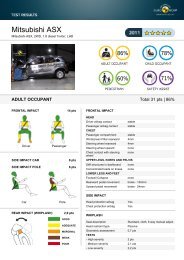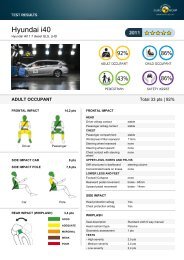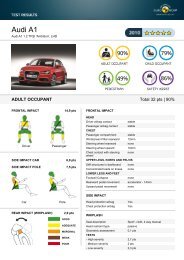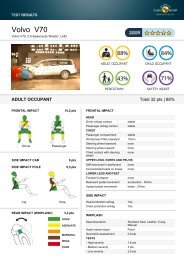Whiplash Testing Protocol - Euro NCAP
Whiplash Testing Protocol - Euro NCAP
Whiplash Testing Protocol - Euro NCAP
Create successful ePaper yourself
Turn your PDF publications into a flip-book with our unique Google optimized e-Paper software.
Version 3.1<br />
June 2011<br />
Alternatively, a CMM may be used. With the seat in the rearmost position, mark a hard point<br />
on the seat and record its location. Move the seat to its most forward adjustment position and<br />
record the position of the seat hard point.<br />
Move the seat rearward until the mark on the seat support structure aligns with centre seat<br />
track mark, or until the marked hard point is midway between the two previously recorded<br />
hard point locations. The final position will depend on whether the seat track adjusts<br />
continuously or incrementally.<br />
The seat should be checked to ensure that both seat runners are set and locked correctly. In<br />
some cases there may be different amounts of travel between the two seat runners, care<br />
should be taken to ensure that in such cases both seat runners are locked in the correct<br />
positions.<br />
4.6.2.3.1 Continuously adjusting seat track. The seat mark should align (± 2mm) with the<br />
mid-track mark. Alternatively, the hard point should have an X-coordinate that is midway<br />
(± 2mm) between the X-coordinates of the forward most and rearward most adjustment<br />
positions.<br />
4.6.2.3.2 Incrementally adjusting seat track. If the midrange adjustment does not correspond to<br />
an incremental adjustment position (± 2mm), then the seat should be set to the first<br />
incremental position rearward of the calculated midrange position.<br />
4.6.2.4 Setting seat height adjustment to midrange. Mark two hard points on the side of the seat,<br />
which are attached to and move with the cushion frame, one near the front of the cushion and<br />
one near the rear. Record the locations of both points with a CMM or measure the vertical<br />
heights of the points relative to a fixed reference with a measuring tape. Use the seat height<br />
adjuster control(s) to move the seat to its highest position. If the front and rear of the seat<br />
adjust separately, then make sure that both the front and rear of the seat are raised to their<br />
highest positions. Record the locations of the two hard points with the CMM or measure the<br />
vertical heights of the points relative to a fixed reference with a measuring tape. Then lower<br />
the seat until both hard points are midway between their highest and lowest positions. The<br />
final position will depend on type of seat height adjuster.<br />
4.6.2.4.1 Single control seat height. If the height is controlled by a single adjuster, its final<br />
position will depend on whether it is continuously or incrementally adjusting.<br />
4.6.2.4.1.1 Continuously adjusting seat height. For single control height adjusters, the rear hard<br />
point should be ± 2mm of the calculated midpoint.<br />
4.6.2.4.1.2 Incrementally adjusting seat height. If the midrange adjustment does not correspond to<br />
an indexed adjustment position (± 2mm), then the seat should be set to the first indexed<br />
position below the calculated midrange position.<br />
4.6.2.4.2 Dual control seat height. If the front and rear of the seat adjust separately, then use the<br />
front adjuster to lower the front hard point and the rear adjuster to lower the rear hard<br />
point. The final position will depend on whether it is continuously or incrementally<br />
adjusting. Note that the adjustment of the front and rear controls may need to be iterated<br />
in order to achieve the calculated midpoints.<br />
10
















